文章目录
一、准备工作(cdh-ipa-v01服务器)
1、hosts添加服务器地址
vi /etc/hosts
192.168.0.200 cdh-cm-v01.yunes.com cdh-cm-v01
192.168.0.201 cdh-master-v01.yunes.com cdh-master-v01
192.168.0.202 cdh-master-v02.yunes.com cdh-master-v02
192.168.0.203 cdh-datanode-v01.yunes.com cdh-datanode-v01
192.168.0.204 cdh-datanode-v02.yunes.com cdh-datanode-v02
192.168.0.205 cdh-datanode-v03.yunes.com cdh-datanode-v03
192.168.0.206 cdh-client-v01.yunes.com cdh-client-v01
192.168.0.207 cdh-ipa-v01.yunes.com cdh-ipa-v01

2、禁用 ipv6
vi /etc/sysctl.conf
net.ipv6.conf.all.disable_ipv6 = 1
net.ipv6.conf.default.disable_ipv6 = 1
net.ipv6.conf.lo.disable_ipv6 = 0
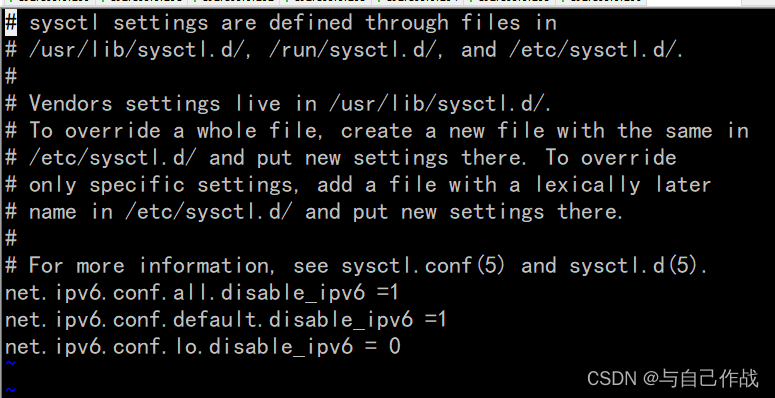
二、freeIPA安装
1、freeIPA安装相关RPM包(cdh-ipa-v01服务器)
yum -y install ipa-server ipa-server-dns
[root@cdh-ipa-v01 ~]# yum -y install ipa-server ipa-server-dns

2、其它节点安装freeipa-client即可
yum -y install freeipa-client
cd ~/scripts/
./ssh_to_all_node.sh “yum -y install freeipa-client”
[root@cdh-cm-v01 disk1]# yum -y install freeipa-client
[root@cdh-cm-v01 disk1]# cd ~/scripts/
[root@cdh-cm-v01 scripts]# ./ssh_to_all_node.sh "yum -y install freeipa-client"

3、执行 ipa-server-install 安装
ipa-server-install --setup-dns --allow-zone-overlap
[root@cdh-ipa-v01 ~]# ipa-server-install --setup-dns --allow-zone-overlap
The log file for this installation can be found in /var/log/ipaserver-install.log
==============================================================================
This program will set up the IPA Server.
This includes:
* Configure a stand-alone CA (dogtag) for certificate management
* Configure the Network Time Daemon (ntpd)
* Create and configure an instance of Directory Server
* Create and configure a Kerberos Key Distribution Center (KDC)
* Configure Apache (httpd)
* Configure DNS (bind)
* Configure the KDC to enable PKINIT
To accept the default shown in brackets, press the Enter key.
Enter the fully qualified domain name of the computer
on which you're setting up server software. Using the form
<hostname>.<domainname>
Example: master.example.com.
Server host name [cdh-ipa-v01.yunes.com]: cdh-ipa-v01.yunes.com
Warning: skipping DNS resolution of host cdh-ipa-v01.yunes.com
The domain name has been determined based on the host name.
Please confirm the domain name [yunes.com]: yunes.com
The kerberos protocol requires a Realm name to be defined.
This is typically the domain name converted to uppercase.
Please provide a realm name [YUNES.COM]: YUNES.COM
Certain directory server operations require an administrative user.
This user is referred to as the Directory Manager and has full access
to the Directory for system management tasks and will be added to the
instance of directory server created for IPA.
The password must be at least 8 characters long.
Directory Manager password: rootROOT@1234
Password (confirm): rootROOT@1234
The IPA server requires an administrative user, named 'admin'.
This user is a regular system account used for IPA server administration.
IPA admin password: adminrootROOT@1234
Password (confirm): adminrootROOT@1234
Checking DNS domain yunes.com., please wait ...
Do you want to configure DNS forwarders? [yes]: yes
Following DNS servers are configured in /etc/resolv.conf: 8.8.8.8, 114.114.114.114
Do you want to configure these servers as DNS forwarders? [yes]: yes
All DNS servers from /etc/resolv.conf were added. You can enter additional addresses now:
Enter an IP address for a DNS forwarder, or press Enter to skip:
Checking DNS forwarders, please wait ...
DNS server 114.114.114.114: answer to query '. SOA' is missing DNSSEC signatures (no RRSIG data)
Please fix forwarder configuration to enable DNSSEC support.
(For BIND 9 add directive "dnssec-enable yes;" to "options {}")
WARNING: DNSSEC validation will be disabled
Do you want to search for missing reverse zones? [yes]: yes
Do you want to create reverse zone for IP 192.168.0.207 [yes]: yes
Please specify the reverse zone name [0.168.192.in-addr.arpa.]:
Using reverse zone(s) 0.168.192.in-addr.arpa.
The IPA Master Server will be configured with:
Hostname: cdh-ipa-v01.yunes.com
IP address(es): 192.168.0.207
Domain name: yunes.com
Realm name: YUNES.COM
BIND DNS server will be configured to serve IPA domain with:
Forwarders: 8.8.8.8, 114.114.114.114
Forward policy: only
Reverse zone(s): 0.168.192.in-addr.arpa.
Continue to configure the system with these values? [no]: yes
The following operations may take some minutes to complete.
Please wait until the prompt is returned.
Configuring NTP daemon (ntpd)
[1/4]: stopping ntpd
[2/4]: writing configuration
[3/4]: configuring ntpd to start on boot
[4/4]: starting ntpd
Done configuring NTP daemon (ntpd).
Configuring directory server (dirsrv). Estimated time: 30 seconds
[1/45]: creating directory server instance
[2/45]: enabling ldapi
[3/45]: configure autobind for root
[4/45]: stopping directory server
[5/45]: updating configuration in dse.ldif
[6/45]: starting directory server
[7/45]: adding default schema
[8/45]: enabling memberof plugin
[9/45]: enabling winsync plugin
[10/45]: configure password logging
[11/45]: configuring replication version plugin
[12/45]: enabling IPA enrollment plugin
[13/45]: configuring uniqueness plugin
[14/45]: configuring uuid plugin
[15/45]: configuring modrdn plugin
[16/45]: configuring DNS plugin
[17/45]: enabling entryUSN plugin
[18/45]: configuring lockout plugin
[19/45]: configuring topology plugin
[20/45]: creating indices
[21/45]: enabling referential integrity plugin
[22/45]: configuring certmap.conf
[23/45]: configure new location for managed entries
[24/45]: configure dirsrv ccache
[25/45]: enabling SASL mapping fallback
[26/45]: restarting directory server
[27/45]: adding sasl mappings to the directory
[28/45]: adding default layout
[29/45]: adding delegation layout
[30/45]: creating container for managed entries
[31/45]: configuring user private groups
[32/45]: configuring netgroups from hostgroups
[33/45]: creating default Sudo bind user
[34/45]: creating default Auto Member layout
[35/45]: adding range check plugin
[36/45]: creating default HBAC rule allow_all
[37/45]: adding entries for topology management
[38/45]: initializing group membership
[39/45]: adding master entry
[40/45]: initializing domain level
[41/45]: configuring Posix uid/gid generation
[42/45]: adding replication acis
[43/45]: activating sidgen plugin
[44/45]: activating extdom plugin
[45/45]: configuring directory to start on boot
Done configuring directory server (dirsrv).
Configuring Kerberos KDC (krb5kdc)
[1/10]: adding kerberos container to the directory
[2/10]: configuring KDC
[3/10]: initialize kerberos container
[4/10]: adding default ACIs
[5/10]: creating a keytab for the directory
[6/10]: creating a keytab for the machine
[7/10]: adding the password extension to the directory
[8/10]: creating anonymous principal
[9/10]: starting the KDC
[10/10]: configuring KDC to start on boot
Done configuring Kerberos KDC (krb5kdc).
Configuring kadmin
[1/2]: starting kadmin
[2/2]: configuring kadmin to start on boot
Done configuring kadmin.
Configuring ipa-custodia
[1/5]: Making sure custodia container exists
[2/5]: Generating ipa-custodia config file
[3/5]: Generating ipa-custodia keys
[4/5]: starting ipa-custodia
[5/5]: configuring ipa-custodia to start on boot
Done configuring ipa-custodia.
Configuring certificate server (pki-tomcatd). Estimated time: 3 minutes
[1/30]: configuring certificate server instance
[2/30]: secure AJP connector
[3/30]: reindex attributes
[4/30]: exporting Dogtag certificate store pin
[5/30]: stopping certificate server instance to update CS.cfg
[6/30]: backing up CS.cfg
[7/30]: disabling nonces
[8/30]: set up CRL publishing
[9/30]: enable PKIX certificate path discovery and validation
[10/30]: starting certificate server instance
[11/30]: configure certmonger for renewals
[12/30]: requesting RA certificate from CA
[13/30]: setting audit signing renewal to 2 years
[14/30]: restarting certificate server
[15/30]: publishing the CA certificate
[16/30]: adding RA agent as a trusted user
[17/30]: authorizing RA to modify profiles
[18/30]: authorizing RA to manage lightweight CAs
[19/30]: Ensure lightweight CAs container exists
[20/30]: configure certificate renewals
[21/30]: configure Server-Cert certificate renewal
[22/30]: Configure HTTP to proxy connections
[23/30]: restarting certificate server
[24/30]: updating IPA configuration
[25/30]: enabling CA instance
[26/30]: migrating certificate profiles to LDAP
[27/30]: importing IPA certificate profiles
[28/30]: adding default CA ACL
[29/30]: adding 'ipa' CA entry
[30/30]: configuring certmonger renewal for lightweight CAs
Done configuring certificate server (pki-tomcatd).
Configuring directory server (dirsrv)
[1/3]: configuring TLS for DS instance
[2/3]: adding CA certificate entry
[3/3]: restarting directory server
Done configuring directory server (dirsrv).
Configuring ipa-otpd
[1/2]: starting ipa-otpd
[2/2]: configuring ipa-otpd to start on boot
Done configuring ipa-otpd.
Configuring the web interface (httpd)
[1/22]: stopping httpd
[2/22]: setting mod_nss port to 443
[3/22]: setting mod_nss cipher suite
[4/22]: setting mod_nss protocol list to TLSv1.2
[5/22]: setting mod_nss password file
[6/22]: enabling mod_nss renegotiate
[7/22]: disabling mod_nss OCSP
[8/22]: adding URL rewriting rules
[9/22]: configuring httpd
[10/22]: setting up httpd keytab
[11/22]: configuring Gssproxy
[12/22]: setting up ssl
[13/22]: configure certmonger for renewals
[14/22]: importing CA certificates from LDAP
[15/22]: publish CA cert
[16/22]: clean up any existing httpd ccaches
[17/22]: configuring SELinux for httpd
[18/22]: create KDC proxy config
[19/22]: enable KDC proxy
[20/22]: starting httpd
[21/22]: configuring httpd to start on boot
[22/22]: enabling oddjobd
Done configuring the web interface (httpd).
Configuring Kerberos KDC (krb5kdc)
[1/1]: installing X509 Certificate for PKINIT
Done configuring Kerberos KDC (krb5kdc).
Applying LDAP updates
Upgrading IPA:. Estimated time: 1 minute 30 seconds
[1/10]: stopping directory server
[2/10]: saving configuration
[3/10]: disabling listeners
[4/10]: enabling DS global lock
[5/10]: disabling Schema Compat
[6/10]: starting directory server
[7/10]: upgrading server
[8/10]: stopping directory server
[9/10]: restoring configuration
[10/10]: starting directory server
Done.
Restarting the KDC
Configuring DNS (named)
[1/12]: generating rndc key file
[2/12]: adding DNS container
[3/12]: setting up our zone
[4/12]: setting up reverse zone
[5/12]: setting up our own record
[6/12]: setting up records for other masters
[7/12]: adding NS record to the zones
[8/12]: setting up kerberos principal
[9/12]: setting up named.conf
[10/12]: setting up server configuration
[11/12]: configuring named to start on boot
[12/12]: changing resolv.conf to point to ourselves
Done configuring DNS (named).
Restarting the web server to pick up resolv.conf changes
Configuring DNS key synchronization service (ipa-dnskeysyncd)
[1/7]: checking status
[2/7]: setting up bind-dyndb-ldap working directory
[3/7]: setting up kerberos principal
[4/7]: setting up SoftHSM
[5/7]: adding DNSSEC containers
[6/7]: creating replica keys
[7/7]: configuring ipa-dnskeysyncd to start on boot
Done configuring DNS key synchronization service (ipa-dnskeysyncd).
Restarting ipa-dnskeysyncd
Restarting named
Updating DNS system records
Configuring client side components
Using existing certificate '/etc/ipa/ca.crt'.
Client hostname: cdh-ipa-v01.yunes.com
Realm: YUNES.COM
DNS Domain: yunes.com
IPA Server: cdh-ipa-v01.yunes.com
BaseDN: dc=yunes,dc=com
Skipping synchronizing time with NTP server.
New SSSD config will be created
Configured sudoers in /etc/nsswitch.conf
Configured /etc/sssd/sssd.conf
trying https://cdh-ipa-v01.yunes.com/ipa/json
[try 1]: Forwarding 'schema' to json server 'https://cdh-ipa-v01.yunes.com/ipa/json'
trying https://cdh-ipa-v01.yunes.com/ipa/session/json
[try 1]: Forwarding 'ping' to json server 'https://cdh-ipa-v01.yunes.com/ipa/session/json'
[try 1]: Forwarding 'ca_is_enabled' to json server 'https://cdh-ipa-v01.yunes.com/ipa/session/json'
Systemwide CA database updated.
Adding SSH public key from /etc/ssh/ssh_host_rsa_key.pub
Adding SSH public key from /etc/ssh/ssh_host_ecdsa_key.pub
Adding SSH public key from /etc/ssh/ssh_host_ed25519_key.pub
[try 1]: Forwarding 'host_mod' to json server 'https://cdh-ipa-v01.yunes.com/ipa/session/json'
SSSD enabled
Configured /etc/openldap/ldap.conf
Configured /etc/ssh/ssh_config
Configured /etc/ssh/sshd_config
Configuring yunes.com as NIS domain.
Client configuration complete.
The ipa-client-install command was successful
==============================================================================
Setup complete
Next steps:
1. You must make sure these network ports are open:
TCP Ports:
* 80, 443: HTTP/HTTPS
* 389, 636: LDAP/LDAPS
* 88, 464: kerberos
* 53: bind
UDP Ports:
* 88, 464: kerberos
* 53: bind
* 123: ntp
2. You can now obtain a kerberos ticket using the command: 'kinit admin'
This ticket will allow you to use the IPA tools (e.g., ipa user-add)
and the web user interface.
Be sure to back up the CA certificates stored in /root/cacert.p12
These files are required to create replicas. The password for these
files is the Directory Manager password

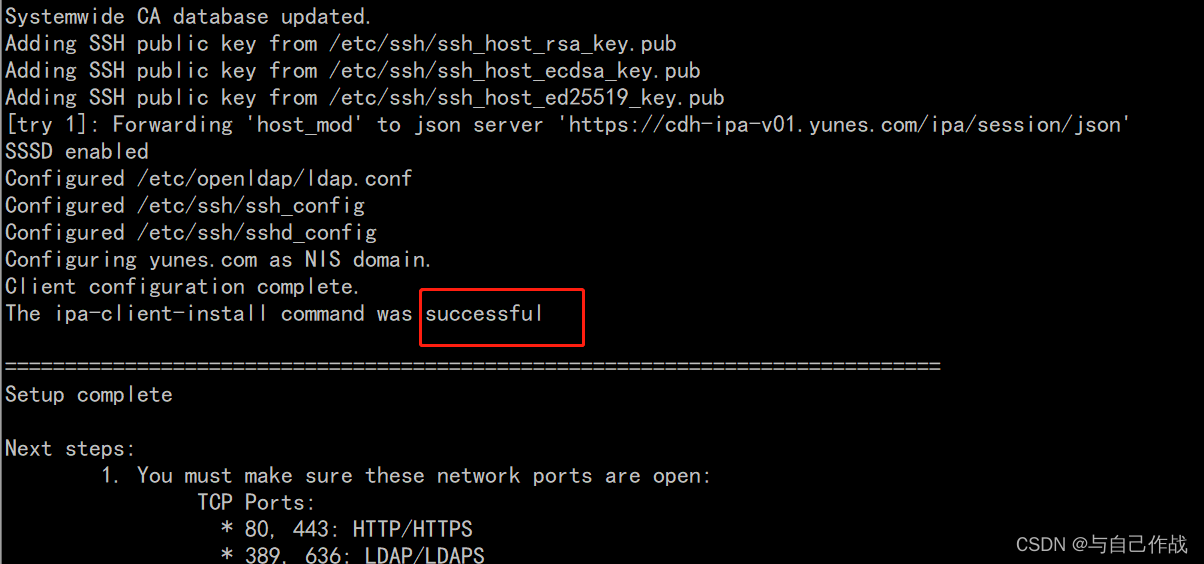
4、备份cacert.p12 文件
cp /root/cacert.p12 /root/cacert.p12.bak.20220923
[root@cdh-ipa-v01 ~]# cp /root/cacert.p12 /root/cacert.p12.bak.20220923

5、配置resolv.conf
1)ipa节点
cat /etc/resolv.conf
[root@cdh-ipa-v01 ~]# cat /etc/resolv.conf
search yunes.com
nameserver 127.0.0.1
2)其它节点
cat /etc/resolv.conf
[root@cdh-cm-v01 scripts]# cat /etc/resolv.conf
# Generated by NetworkManager
search yunes.com
nameserver 192.168.0.207
nameserver 8.8.8.8
nameserver 114.114.114.114
[root@cdh-cm-v01 scripts]# ./sync_to_all_node.sh /etc/resolv.conf /etc/
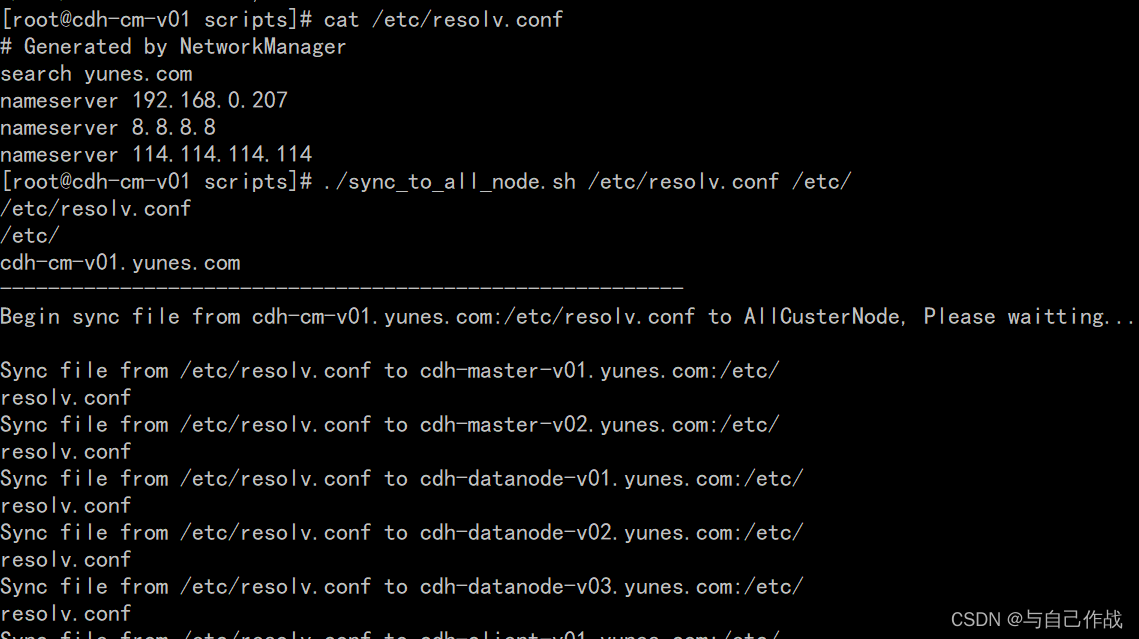
6、启用PTR记录同步
1)登录票据管理员
kinit admin
[root@cdh-ipa-v01 ~]# kinit admin
Password for admin@YUNES.COM: adminrootROOT@1234

2)获取创建的DNS区域列表
ipa dnszone-find --all | grep -E “Zone name|区域名”
[root@cdh-ipa-v01 ~]# ipa dnszone-find --all | grep -E "Zone name|区域名"
Zone name: 0.168.192.in-addr.arpa.
Zone name: yunes.com.

3)启用PTR同步
ipa dnszone-mod yunes.com --allow-sync-ptr=true
[root@cdh-ipa-v01 ~]# ipa dnszone-mod yunes.com --allow-sync-ptr=true
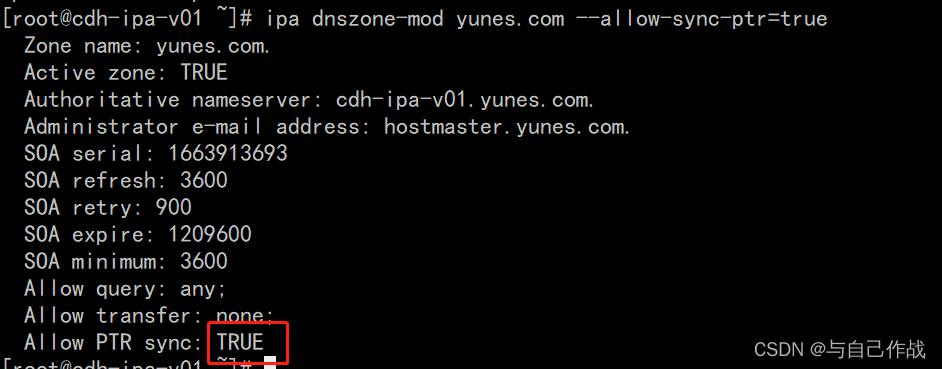
4)配置密码永不过期
ipa pwpolicy-mod --maxlife=0 --minlife=0 global_policy
[root@cdh-ipa-v01 ~]# ipa pwpolicy-mod --maxlife=0 --minlife=0 global_policy

5)查看FreeIPA各服务运行情况
ipactl status
[root@cdh-ipa-v01 ~]# ipactl status
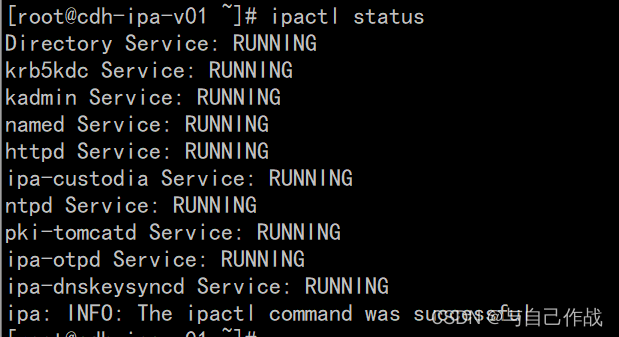
7、登录freeIPA UI界面
https://cdh-ipa-v01.yunes.com/ipa/ui
https://192.168.0.207/ipa/ui
https://192.168.0.207/ipa/ui
https://cdh-ipa-v01.yunes.com/ipa/ui
用户名:admin
密码:adminrootROOT@1234
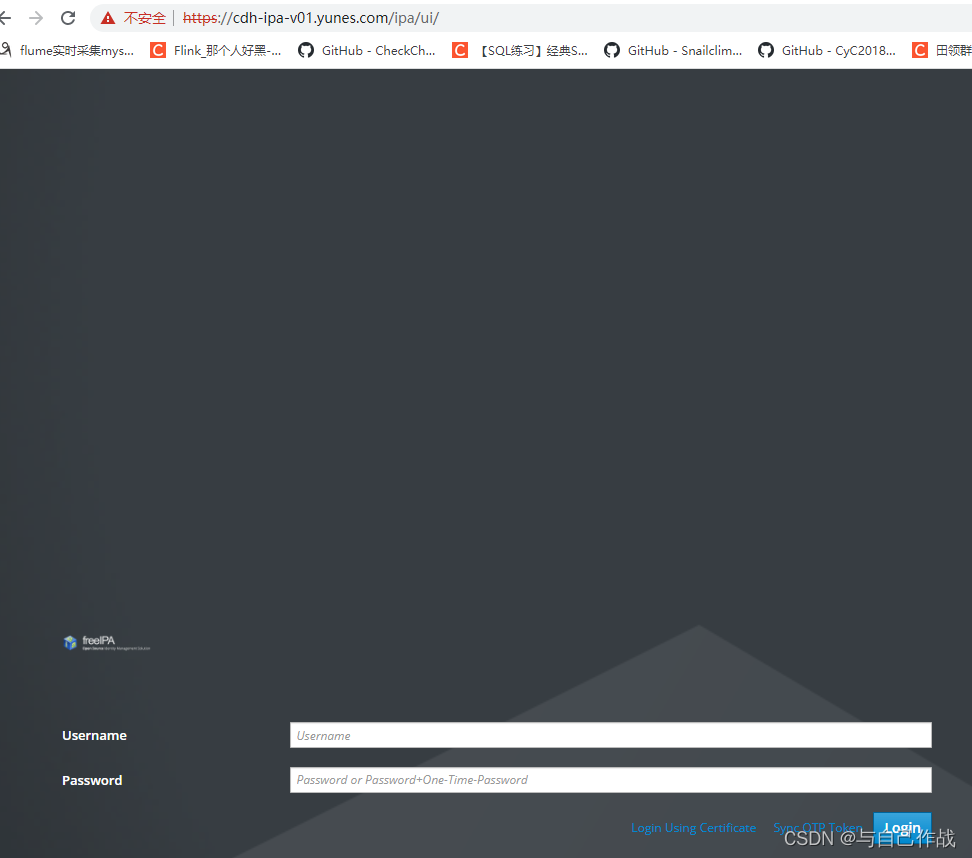

The log file for this installation can be found in /var/log/ipaserver-install.log
This program will set up the IPA Server.
This includes:
- Configure a stand-alone CA (dogtag) for certificate management
- Configure the Network Time Daemon (ntpd)
- Create and configure an instance of Directory Server
- Create and configure a Kerberos Key Distribution Center (KDC)
- Configure Apache (httpd)
- Configure DNS (bind)
- Configure the KDC to enable PKINIT
To accept the default shown in brackets, press the Enter key.
Enter the fully qualified domain name of the computer
on which you’re setting up server software. Using the form
.
Example: master.example.com.Server host name [cdh-ipa-v01.yunes.com]: cdh-ipa-v01.yunes.com
Warning: skipping DNS resolution of host cdh-ipa-v01.yunes.com
The domain name has been determined based on the host name.Please confirm the domain name [yunes.com]: yunes.com
The kerberos protocol requires a Realm name to be defined.
This is typically the domain name converted to uppercase.Please provide a realm name [YUNES.COM]: YUNES.COM
Certain directory server operations require an administrative user.
This user is referred to as the Directory Manager and has full access
to the Directory for system management tasks and will be added to the
instance of directory server created for IPA.
The password must be at least 8 characters long.Directory Manager password: rootROOT@1234
Password (confirm): rootROOT@1234The IPA server requires an administrative user, named ‘admin’.
This user is a regular system account used for IPA server administration.IPA admin password: adminrootROOT@1234
Password (confirm): adminrootROOT@1234Checking DNS domain yunes.com., please wait …
Do you want to configure DNS forwarders? [yes]: yes
Following DNS servers are configured in /etc/resolv.conf: 8.8.8.8, 114.114.114.114
Do you want to configure these servers as DNS forwarders? [yes]: yes
All DNS servers from /etc/resolv.conf were added. You can enter additional addresses now:
Enter an IP address for a DNS forwarder, or press Enter to skip:
Checking DNS forwarders, please wait …
DNS server 114.114.114.114: answer to query ‘. SOA’ is missing DNSSEC signatures (no RRSIG data)
Please fix forwarder configuration to enable DNSSEC support.
(For BIND 9 add directive “dnssec-enable yes;” to “options {}”)
WARNING: DNSSEC validation will be disabled
Do you want to search for missing reverse zones? [yes]: yes
Do you want to create reverse zone for IP 192.168.0.207 [yes]: yes
Please specify the reverse zone name [0.168.192.in-addr.arpa.]:
Using reverse zone(s) 0.168.192.in-addr.arpa.The IPA Master Server will be configured with:
Hostname: cdh-ipa-v01.yunes.com
IP address(es): 192.168.0.207
Domain name: yunes.com
Realm name: YUNES.COMBIND DNS server will be configured to serve IPA domain with:
Forwarders: 8.8.8.8, 114.114.114.114
Forward policy: only
Reverse zone(s): 0.168.192.in-addr.arpa.Continue to configure the system with these values? [no]: yes
The following operations may take some minutes to complete.
Please wait until the prompt is returned.Configuring NTP daemon (ntpd)
[1/4]: stopping ntpd
[2/4]: writing configuration
[3/4]: configuring ntpd to start on boot
[4/4]: starting ntpd
Done configuring NTP daemon (ntpd).
Configuring directory server (dirsrv). Estimated time: 30 seconds
[1/45]: creating directory server instance
[2/45]: enabling ldapi
[3/45]: configure autobind for root
[4/45]: stopping directory server
[5/45]: updating configuration in dse.ldif
[6/45]: starting directory server
[7/45]: adding default schema
[8/45]: enabling memberof plugin
[9/45]: enabling winsync plugin
[10/45]: configure password logging
[11/45]: configuring replication version plugin
[12/45]: enabling IPA enrollment plugin
[13/45]: configuring uniqueness plugin
[14/45]: configuring uuid plugin
[15/45]: configuring modrdn plugin
[16/45]: configuring DNS plugin
[17/45]: enabling entryUSN plugin
[18/45]: configuring lockout plugin
[19/45]: configuring topology plugin
[20/45]: creating indices
[21/45]: enabling referential integrity plugin
[22/45]: configuring certmap.conf
[23/45]: configure new location for managed entries
[24/45]: configure dirsrv ccache
[25/45]: enabling SASL mapping fallback
[26/45]: restarting directory server
[27/45]: adding sasl mappings to the directory
[28/45]: adding default layout
[29/45]: adding delegation layout
[30/45]: creating container for managed entries
[31/45]: configuring user private groups
[32/45]: configuring netgroups from hostgroups
[33/45]: creating default Sudo bind user
[34/45]: creating default Auto Member layout
[35/45]: adding range check plugin
[36/45]: creating default HBAC rule allow_all
[37/45]: adding entries for topology management
[38/45]: initializing group membership
[39/45]: adding master entry
[40/45]: initializing domain level
[41/45]: configuring Posix uid/gid generation
[42/45]: adding replication acis
[43/45]: activating sidgen plugin
[44/45]: activating extdom plugin
[45/45]: configuring directory to start on boot
Done configuring directory server (dirsrv).
Configuring Kerberos KDC (krb5kdc)
[1/10]: adding kerberos container to the directory
[2/10]: configuring KDC
[3/10]: initialize kerberos container
[4/10]: adding default ACIs
[5/10]: creating a keytab for the directory
[6/10]: creating a keytab for the machine
[7/10]: adding the password extension to the directory
[8/10]: creating anonymous principal
[9/10]: starting the KDC
[10/10]: configuring KDC to start on boot
Done configuring Kerberos KDC (krb5kdc).
Configuring kadmin
[1/2]: starting kadmin
[2/2]: configuring kadmin to start on boot
Done configuring kadmin.
Configuring ipa-custodia
[1/5]: Making sure custodia container exists
[2/5]: Generating ipa-custodia config file
[3/5]: Generating ipa-custodia keys
[4/5]: starting ipa-custodia
[5/5]: configuring ipa-custodia to start on boot
Done configuring ipa-custodia.
Configuring certificate server (pki-tomcatd). Estimated time: 3 minutes
[1/30]: configuring certificate server instance
[2/30]: secure AJP connector
[3/30]: reindex attributes
[4/30]: exporting Dogtag certificate store pin
[5/30]: stopping certificate server instance to update CS.cfg
[6/30]: backing up CS.cfg
[7/30]: disabling nonces
[8/30]: set up CRL publishing
[9/30]: enable PKIX certificate path discovery and validation
[10/30]: starting certificate server instance
[11/30]: configure certmonger for renewals
[12/30]: requesting RA certificate from CA
[13/30]: setting audit signing renewal to 2 years
[14/30]: restarting certificate server
[15/30]: publishing the CA certificate
[16/30]: adding RA agent as a trusted user
[17/30]: authorizing RA to modify profiles
[18/30]: authorizing RA to manage lightweight CAs
[19/30]: Ensure lightweight CAs container exists
[20/30]: configure certificate renewals
[21/30]: configure Server-Cert certificate renewal
[22/30]: Configure HTTP to proxy connections
[23/30]: restarting certificate server
[24/30]: updating IPA configuration
[25/30]: enabling CA instance
[26/30]: migrating certificate profiles to LDAP
[27/30]: importing IPA certificate profiles
[28/30]: adding default CA ACL
[29/30]: adding ‘ipa’ CA entry
[30/30]: configuring certmonger renewal for lightweight CAs
Done configuring certificate server (pki-tomcatd).
Configuring directory server (dirsrv)
[1/3]: configuring TLS for DS instance
[2/3]: adding CA certificate entry
[3/3]: restarting directory server
Done configuring directory server (dirsrv).
Configuring ipa-otpd
[1/2]: starting ipa-otpd
[2/2]: configuring ipa-otpd to start on boot
Done configuring ipa-otpd.
Configuring the web interface (httpd)
[1/22]: stopping httpd
[2/22]: setting mod_nss port to 443
[3/22]: setting mod_nss cipher suite
[4/22]: setting mod_nss protocol list to TLSv1.2
[5/22]: setting mod_nss password file
[6/22]: enabling mod_nss renegotiate
[7/22]: disabling mod_nss OCSP
[8/22]: adding URL rewriting rules
[9/22]: configuring httpd
[10/22]: setting up httpd keytab
[11/22]: configuring Gssproxy
[12/22]: setting up ssl
[13/22]: configure certmonger for renewals
[14/22]: importing CA certificates from LDAP
[15/22]: publish CA cert
[16/22]: clean up any existing httpd ccaches
[17/22]: configuring SELinux for httpd
[18/22]: create KDC proxy config
[19/22]: enable KDC proxy
[20/22]: starting httpd
[21/22]: configuring httpd to start on boot
[22/22]: enabling oddjobd
Done configuring the web interface (httpd).
Configuring Kerberos KDC (krb5kdc)
[1/1]: installing X509 Certificate for PKINIT
Done configuring Kerberos KDC (krb5kdc).
Applying LDAP updates
Upgrading IPA:. Estimated time: 1 minute 30 seconds
[1/10]: stopping directory server
[2/10]: saving configuration
[3/10]: disabling listeners
[4/10]: enabling DS global lock
[5/10]: disabling Schema Compat
[6/10]: starting directory server
[7/10]: upgrading server
[8/10]: stopping directory server
[9/10]: restoring configuration
[10/10]: starting directory server
Done.
Restarting the KDC
Configuring DNS (named)
[1/12]: generating rndc key file
[2/12]: adding DNS container
[3/12]: setting up our zone
[4/12]: setting up reverse zone
[5/12]: setting up our own record
[6/12]: setting up records for other masters
[7/12]: adding NS record to the zones
[8/12]: setting up kerberos principal
[9/12]: setting up named.conf
[10/12]: setting up server configuration
[11/12]: configuring named to start on boot
[12/12]: changing resolv.conf to point to ourselves
Done configuring DNS (named).
Restarting the web server to pick up resolv.conf changes
Configuring DNS key synchronization service (ipa-dnskeysyncd)
[1/7]: checking status
[2/7]: setting up bind-dyndb-ldap working directory
[3/7]: setting up kerberos principal
[4/7]: setting up SoftHSM
[5/7]: adding DNSSEC containers
[6/7]: creating replica keys
[7/7]: configuring ipa-dnskeysyncd to start on boot
Done configuring DNS key synchronization service (ipa-dnskeysyncd).
Restarting ipa-dnskeysyncd
Restarting named
Updating DNS system records
Configuring client side components
Using existing certificate ‘/etc/ipa/ca.crt’.
Client hostname: cdh-ipa-v01.yunes.com
Realm: YUNES.COM
DNS Domain: yunes.com
IPA Server: cdh-ipa-v01.yunes.com
BaseDN: dc=yunes,dc=comSkipping synchronizing time with NTP server.
New SSSD config will be created
Configured sudoers in /etc/nsswitch.conf
Configured /etc/sssd/sssd.conf
trying https://cdh-ipa-v01.yunes.com/ipa/json
[try 1]: Forwarding ‘schema’ to json server ‘https://cdh-ipa-v01.yunes.com/ipa/json’
trying https://cdh-ipa-v01.yunes.com/ipa/session/json
[try 1]: Forwarding ‘ping’ to json server ‘https://cdh-ipa-v01.yunes.com/ipa/session/json’
[try 1]: Forwarding ‘ca_is_enabled’ to json server ‘https://cdh-ipa-v01.yunes.com/ipa/session/json’
Systemwide CA database updated.
Adding SSH public key from /etc/ssh/ssh_host_rsa_key.pub
Adding SSH public key from /etc/ssh/ssh_host_ecdsa_key.pub
Adding SSH public key from /etc/ssh/ssh_host_ed25519_key.pub
[try 1]: Forwarding ‘host_mod’ to json server ‘https://cdh-ipa-v01.yunes.com/ipa/session/json’
SSSD enabled
Configured /etc/openldap/ldap.conf
Configured /etc/ssh/ssh_config
Configured /etc/ssh/sshd_config
Configuring yunes.com as NIS domain.
Client configuration complete.
The ipa-client-install command was successful==============================================================================
Setup completeNext steps:
1. You must make sure these network ports are open:
TCP Ports:
* 80, 443: HTTP/HTTPS
* 389, 636: LDAP/LDAPS
* 88, 464: kerberos
* 53: bind
UDP Ports:
* 88, 464: kerberos
* 53: bind
* 123: ntp2. You can now obtain a kerberos ticket using the command: 'kinit admin' This ticket will allow you to use the IPA tools (e.g., ipa user-add) and the web user interface.Be sure to back up the CA certificates stored in /root/cacert.p12
These files are required to create replicas. The password for these
files is the Directory Manager password